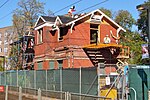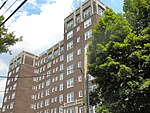Lincoln Drive
1856 establishments in PennsylvaniaPennsylvania road stubsRoads in PennsylvaniaStreets in PhiladelphiaTransportation in Philadelphia

Lincoln Drive is a 4.1 mile road in the Wissahickon Creek section of Philadelphia, Pennsylvania. Initially built in 1856 as the Wissahickon Turnpike, it was not completed until about 50 years later. The road is called the “Dead Man’s Gulch” due to its twisting and turning. Initially, the purpose of the road was to provide access from the mills to the city of Philadelphia.Some historic locations that the road passes include Historic RittenhouseTown, Germantown, and Chestnut Hill. From the 1930s until 1960, Lincoln Drive was designated as the southernmost part of U.S. Route 309.
Excerpt from the Wikipedia article Lincoln Drive (License: CC BY-SA 3.0, Authors, Images).Lincoln Drive
Lincoln Drive, Philadelphia
Geographical coordinates (GPS) Address Nearby Places Show on map
Geographical coordinates (GPS)
| Latitude | Longitude |
|---|---|
| N 40.0376 ° | E -75.19115 ° |
Address
Lincoln Drive 6458
19144 Philadelphia
Pennsylvania, United States
Open on Google Maps








